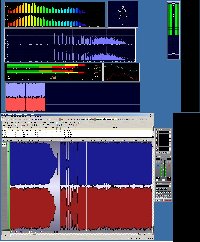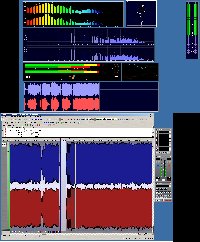Why's It So Loud?or Don't You Play
any Nice Songs?
back to main turd
NOTE - make sure you scroll down and
read the rant below! I try to explain why this is happening - at least
what I think (ya, I know...)
Best quote I've ever heard on the
subject from the amazing Bob Katz: "But
when all the lights are lit on the peak,
you win, right?"
|
Here are some
links to mastering software analysis of part of a song from the latest
Metallica CD - Death Magnetic.
NOTE: each page is a bit
large. This is a Katz K-14
metering
with AES 17 for RMS. Notice
the crest factor - the
RMS level to peak levels. The
extreme RMS values are some of the highest I've seen in
commercial recordings.
I will not offer
comments or qualitative opinions of the recordings - I think Rubin may
like the controversy esp. in this music biz climate.
|
|
From
the CD - ripped into Wavelab 6.01
At this moment in the song, peak is showing 0 DBFS (+14
is K14 0) with an RMS value at 2.85 db below that (+11.15 K14).
|
From
ITUNES - using the ITUNES Burn CD-
Ripped into Wavelab 6.01
At this moment in
the
song, peak is
showing 0.63 DBFS (+13 where +14 is K14 0) with a RMS only 3
below
that (+10.49 K14).
|
Now this is interesting - on this page note
the difference in selections on the CD - some are
brickwalled/flat-topped and some are ragged - in fact, some of the ones
flat-topped actually have HIGHER RMS to Peak ratios.
|
|
|
|
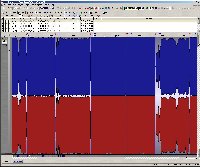
Click
here or on the above image - CD track compare
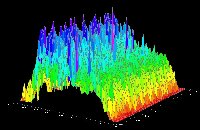
Click
here or on the above image - CD Track 6 further analysis
|
Comments to a Lefsetz article:
I really got a buncha meetings for my day job today so I'd
love to explore this a bit more... but hey here's some of my
observations and opinions.... for what any of it is worth -
What I think your reader means is the change in crest factor between
new stuff and older recordings. In my mastering suite, I have reference
CD rips from recent stuff with the typical squashed sound and stuff,
even as recent as Blood Sugar Sex Magic and Pearl Jams's 10... big diff
in RMS vs Peak ratios....
I believe the reason for the 6db crest factor is the change of the
consumer systems... and maybe what Katz (I've talked to him a few
times) mentions, a shifting threshold in the consumers hearing/ambient
noise factors. Significance must be given though, to the smaller driver
surface area, now typical in modern consumer repro systems.
I think a lot of investigation needs to be focused on the comparison of
speaker driver surface area, the effects on instantaneous excitation of
the acoustic environment, the ratio and linearity of frequency response
to this instantaneous ability in typical home acoustic environments,
and how the ear perceives the difference in loudness (ie RMS vs peak
program) to these factors.
In his book Mastering Audio (he's fucking amazing/great) he delves into
the whole squished audio thing....
As to clipping consumer CD players, a few things... recall I design
this shit.... the post DAC analog stages vary as to the matching the
designer achieves with regard to 0dB-FS levels of the DAC amp (usually
an opamp) to the remaining analog stages... I've noticed a significant
difference in low-end CD players.
When mastering Jon's stuff, I noticed severe clipping when I ran close
to -0.1dB-FS (this is where the 16 bits go to all 1's) on a few of the
small CD players in the house. Believe me, when on a small budget like
this, you make the rounds thru the house and to every Best Buy,
Tweeter, Target with master CD in hand to see how it translates. Any
colleague with a CD in the car gets approached...
So I began running absolute noise shaped (this means there's no two-
four 16 bit
words adjacent in the stream when it gets near the peak limit) to
-0.3dB-FS.
Problem solved.... after dissecting a few of the offending units and
placing a scope probe on the DAC outputs and the following analog
stages, I noticed a huge difference between the CD's limited at
-0.1dB-FS and those at -0.3.
Some guys set their limiters at -0.01dB-FS - I've had some major label
releases totally trash these poor little CD players; even some of the
high end units suffer from this type of overload.
As to my theory, look at most consumer 5.1 systems. Very small driver
area. Higher RMS vs peak levels will make most program material sound
louder on smaller systems, due to the fact that the ear/brain gauges
loudness based on continuous energy levels and has very limited ability
to discern peak information.
The majority of the people listen to earbuds.... they're tone deaf...
want to bounce to thumpy synth dance music or noisy rock... with sound
systems that have a lot less fidelity than the speakers you mentioned
you have.
Did you ever listen to the sound
coming from the guys that DO spend
money on cars stereos? Yea... probably something like 10% IM
distortion. Whumpa Whumpa ... the fucking trunk lid's vibrating. That's
real pleasant...great fidelity, even if the source was a zillion
bit/1GHz sample rates.
With this in mind, realize
that the consumer will usually end up doing their own sort of limiting
- - clipping to the power supply rails in their playback system.
I really don't think the majority of people care a lot about
"fidelity"...
And it's really not a "new" thing. Just look how long studios, all
studios, have had "nearfields/bookshelf speakers" like Yamaha NS-10's
(usually with toilet paper taped over the tweeter), and Auratones to
mix thru. Then of course you gotta check your mix in a
standard-equipped auto sound system, with the smiley face on the
graphic EQ (see Bob Katz's "Mastering Audio 1st Edition - 'Here's what
we're up against' " photo on page 81 for that) just like Suzie has her
car stereo adjusted. A lot of stuff is mixed/pre-mastered for the
lowest common denominator.
With smaller and smaller driver surface area, most music is so squashed
to compete and be heard over noisy environs, dynamic range is what?
Maybe 6db RMS/Peak?
Just like you mentioned, most people do stuff while they listen, they
don't stay in one place as when decent sound reproduction was a
novelty, one of few entertainment outlets "on demand" for the consumer.
That's one of the advantages for music/aural-only entertainment - you
can do other stuff while being entertained. I agree some like you and I
may be able to become engrossed in listening to pre-recorded music, but
to most people, it's just a noise backdrop to their daily chores.
They drive Hondas or Fords....and in this economic environment, I'm not
so sure that'd be a wise biz move, to try and sell the public on, "...
hey, once again, we'll give you higher quality... " marketing goop....
not when they can barely afford to put gas in the tank of that
Honda/Ford... and now, food shortage scares...My guess is with these
economic swings, we ain't seen nothing yet as to the impact on
discretionary spending.
I mean, it's possible that the music/electronics industry could be like
other recent industries and say, "Fuck you... we changed the rules...
now you have to buy our new IPODs for the 500K, 64 bit sample rate...."
and make it stick. Maybe it's possible when they can connect your
IPOD directly to your aural nerves and inject it straight into your
brain....I don't think most people would hear the diff on their
laptops...not thru 1 watt earbuds.
--------------------------------
Edited version of a Wikipedia
page discussion:
As to broadcast engineering in the mid 80's to early 90's, one
of the first
multiband limiters beyond the Optimod that I recall installing/using
was the Texar 4-band.
Some great vids on Youtube of
both
the Optimod and Texar Audio Prism:
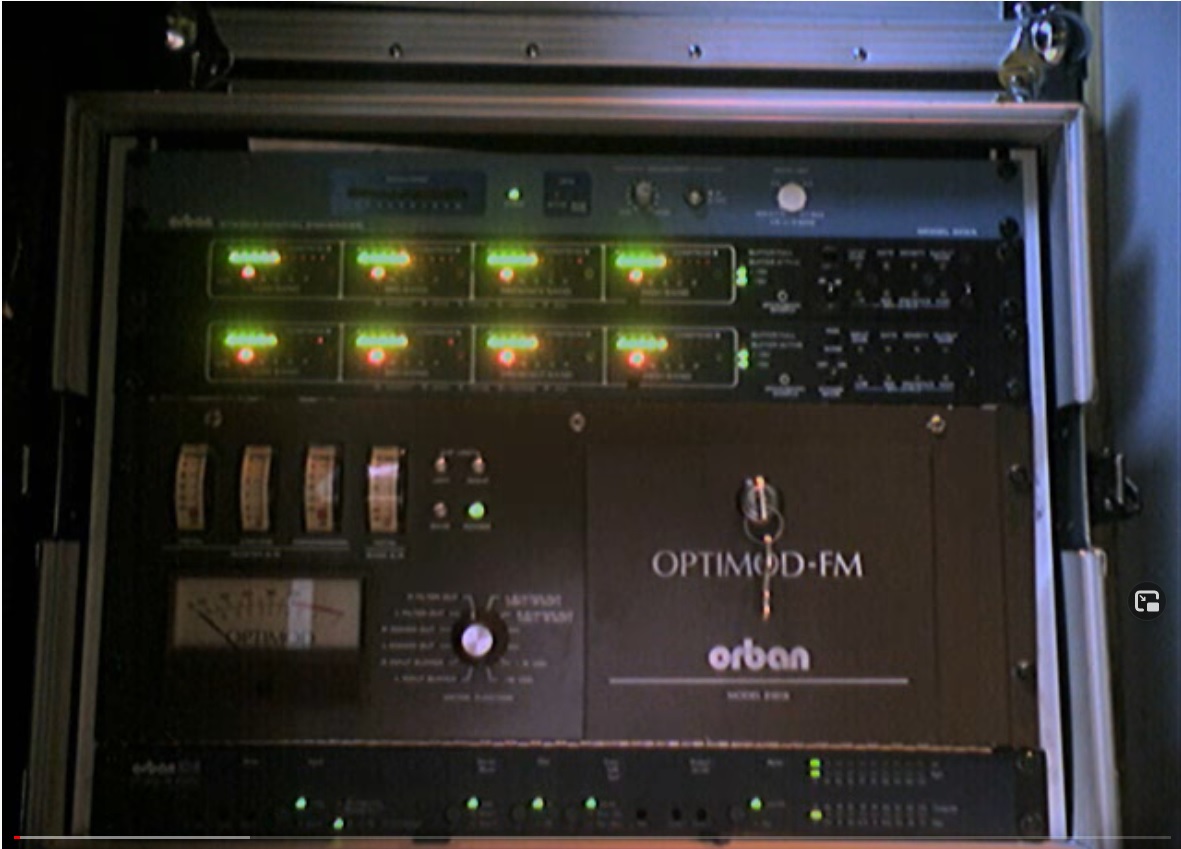
http://www.youtube.com/watch?v=DXZioXlbu3s
http://www.youtube.com/watch?v=fM8l0fJfM-4
So as you can see, multiband limiting is nothing new.
Recall Orban Optimods did do a sort of multiband
limiting but also performed many other FM-related audio processing
functions with some versions being the station's stereo pilot
generator/processor. We used both in many of the FM's I worked at. This
leads me to think that exploration of some of the artifacts (such as
intermod distortion) of "misuse"
(subjective) of multibands should be
mentioned.
Also, the reason we as broadcast engineers used such multiband devices
was to get above road noise, receiver noise/multipath whaps, satisfy
the management as
to the perception upon listeners changing stations an apparently
louder station, etc... It was
also due to the fact that the FCC would monitor stations for peaks over
100%
(with no SCA's; 110% max with SCA's) and FINE the station if more
than 2 peaks over threshold were detected. Bad stuff. Our local
monitoring facility in Langhorne PA was especially strict about going
over allocated spectra (typically a deviation of ~ +/-75kHz)
From the FCC
§ 73.1570 Modulation levels: AM, FM, TV and Class A TV
aural:
(2) FM
stations. The total modulation must not exceed 100 percent on peaks of
frequent reoccurrence referenced to 75 kHz deviation. However, stations
providing subsidiary communications services using subcarriers under
provisions of §73.319 concurrently with the broadcasting of
stereophonic or monophonic programs may increase the peak modulation
deviation as follows:
(i) The total peak
modulation may be increased 0.5 percent for each 1.0 percent subcarrier
injection modulation.
(ii) In no event
may the modulation of the carrier exceed 110 percent (82.5 kHz peak
deviation).
A great view of the RF spectral content of a typical FM
broadcast can be seen here: http://en.wikipedia.org/wiki/File:FM_spectrum_no_IBOC.png
From the subject: http://en.wikipedia.org/wiki/HD_Radio
-------------------------------------------------------
Also, I did a bit of research (you can see my lab at http://www.ajawamnet.com
) on playback of various audio devices (MP3
player, cheap and not-so-cheap CD players) and what I found causing the
crackling with "hot" CD's/MP3's processed to within 0.01DBFS is
limitations in the D2A sections and successive analog stages causing
the familiar cracking sound. I did this because I noticed that certain
playback devices did NOT do this, having sufficient headroom in the
analog section.
I've noticed a recent trend in "hot" masters going to absolute
values of -0.1 to absolute limits around -0.3DBFS, which is
below the "crackling" threshold of
even the cheapest of playback devices, such as those sold in toy
sections of most retailers.
Please note that most of the digital plug-ins and in-line comp/limiters
used for digital pre-mastering actually do not "clip". Adjacent
16/24/32 bit words with the same bit train are typically
shown as errors in most mastering software; Wavelab allows one to set
the threshold in its Global Analysis - Errors
tool.
Even Wavelab will show this as a digital "clip" when using their
analysis tools (not the real time meters). Therefore most of the
limiters I use in the digital domain, such as TC, Voxengo, Waves, etc.
produce even the heaviest of limiting with non-repeating maximum word
values. One can see this if you zoom into the waveview on any DAW and
see that the absolute values are never (or should never be) adjacent.
Replicators will usually bounce these "gold discs" upon inspection
before
going to CD master cutting.
I also believe that this should not become a soapbox for what people
think is right or "audiophile" since it has little to do with the
factual interpretation of trends towards higher RMS values. I will say
that it should be mentioned in very agnostic terms that it is the
opinion that ear fatigue may be caused by reduced RMS to Peak ratios,
but subjective views of what "sounds good" are just that - subjective.
As to the reasons that this is occurring, a few reasons are mentioned
in Katz's book Mastering Audio, one being an increase in ambient noise
in listening environments and the resulting effect on what he terms as
something like listener threshold.
But my feeling is that we've been seeing a reduction in speaker driver
size, and to me, a limitation of the instantaneous ability of a
reproduction system to excite a certain volume of air in the listener's
environment at all spectra results in the typical listener stating that
something sounds better on these smaller, multichannel home systems,
small computer speakers, etc... when the program material has higher
RMS levels.
The effects are compounded by non-ideal room geometry and dimensions as
well as placement of the speakers/drivers by the consumer. It's fairly
obvious that these systems exist in non-ideal environments which causes
a multitude of problems.
When I worked with the Pittsburgh Symphony, it was interesting to hear
the amount of dynamic generated by 108 players at forte during
something like Copeland's Rodeo. All of those sound generating
elements, able to excite that much air instantaneously was an eye (ear)
opener. Same with being onstage at large venues during many of the rock
acts I did monitors for. Having that much surface area all working in
consort is something not easily achievable in the typical consumer
listening environment.
As to an expert, you really should refer to some of the mastering gurus
and see if they'd like to contribute. Katz, Ludwig, Smith and others
have been doing this for years and have seen the desire of bands,
producers, and A&R men evolve to these "loudness wars". In fact,
Wavelab now offers a Katz-style meter, which opinions vary, to gauge
apparent loudness.
Wamnet 15:16, 8 April 2007 (UTC)
---------------
The Original Mastering Engineer
article from Wikipedia
Note:
This was the original version of the
topic I started on Wikipedia titled Mastering Engineer. By now it's totally unrecognizable
due to the constant bickering and posturing of the wikipedia
population.
By now it may even have merged into
the Mastering topic.
They all think J-Lo will (INSERT
FAVORITE SEX ACT HERE) if they're the ones that have the final
top-dog say... everyone's a rock star.
Oh well. There's so much personal
opinion that it's about worthless now. Just
like there's good open source software like Blender, there's also a lot
of shit that comes with open, GPL'd stuff.
Anyway here it is,
the original version:
Mastering engineer
From Wikipedia, the free encyclopedia
A
music mastering engineer is one skilled in the practice of taking audio
(typically musical content) that's been previously mixed in either the
analog or digital domain as mono, stereo, or multichannel formats and
preparing it for use in distribution, whether by physical media such as
a CD, or as some method of streaming audio.
Confusion exists as to the term mastering, with the most descriptive
of these being pre-mastering to discern it from the actual process of
making replication masters for replication/duplication of physical
media distributed to consumers such as a vinyl record album or a
compact audio disc (CD).
Typical pre-mastering involves processing the audio for the various
media targeted. Depending on the medium, it can involve sequencing
musical selections, adding necessary timing between selections, adding
neccesary coding or information to digital streams for various uses
such as PQ codes for CD track indexing, etc.
But most accolades given to mastering engineers is their ability to
make a mix consistent with respect to subjective factors based on
perception of listeners, regardless of the playback system or
environment of the consumer. This can be difficult with respect to the
varieties of systems now available that the audio selection may be
reproduced on, and the effect it has on the apparent generally-accepted
qualitative attributes of the recording. For instance, a recording that
sounds great on one speaker/amplifier combination playing CD audio may
sound totally different on a computer-based system playing back a
low-bitrate MP3.
Add to this the variations in listening environments, (autos, movie
soundtrack usage, noisy kitchen, poor acoustics) as well as the
placement/coupling to that environment of the sound system in use and
one can see the difficulty in providing a consistent listening
experience to the consumer.
This is why it's considered as an art as well as an "audio
engineering" dicipline.
Another major function in pre-mastering is to ensure that the final
product does not exceed the capabilities of the medium used to
distribute the final sound recording. Avoiding distortion of various
types as well as generally accepted spectral balance and apparent
volume adds a layer of complexity to the process.
Currently, trends in pre-mastering has led to higher values of what
is, in simple terms, the apparent average sound pressure level or
volume of the reproduction when listened to on the varity of consumer
audio equipment. One need only to play back a recording made recently,
and without changing the reproduction systems gain (ie. volume control)
play back an older non-remastered recording and compare the difference
in how loud it seems.
This change in what is typically known in the practice of
pre-mastering as the use of higher ratios of compression/limiting is
probably due to numerous factors, one being the the general consensus
in the study of the mechanics of human hearing that the ear is more
sensitive to apparent average sound pressure than it is to sound
comprising of shorter-duration peak levels. It also appears to be
market driven and genre-specific, with popular styles of music tending
towards recent trends of higher average program content then say
classsical recordings when comparing music distributed in the last
10-15 years.
back to main turd


